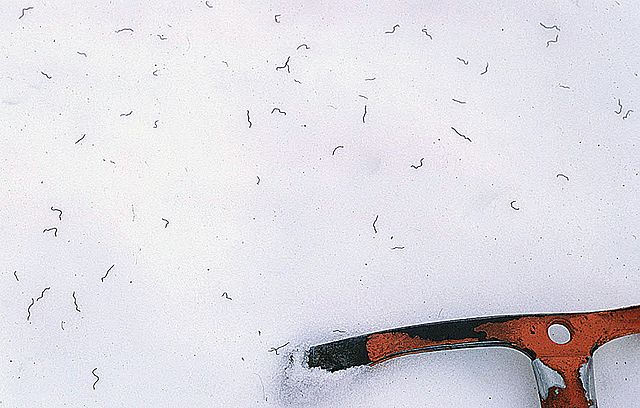 Each summer, the seemingly barren glaciers of Alaska, British Columbia, and the Pacific Northwest come to life, as billions of ice worms emerge from the ice.
Each summer, the seemingly barren glaciers of Alaska, British Columbia, and the Pacific Northwest come to life, as billions of ice worms emerge from the ice.
Like a tapestry of black threads, the wriggling worms present a mystery to scientists.
Little is known about these critters, but if scientists wish to research these lifeforms, they will have to act fast. Glaciers, the worms’ natural habitat, are shrinking rapidly.
Let’s take a look at ice worms and their annual appearance.
Ice Worms: Living Life on the Edge
The black ice worms (Mesenchytraeus solifugus) are small in size, reaching one to three centimeters long. Nearly 5 billion worms can inhabit a single glacier. Despite spending most of their lives encased in ice, ice worms cannot tolerate freezing and will die if temperatures are less than 0º C (32º F).
Scott Hotaling, a biologist at Washington State University studying ice worms, suspects that the worms keep warm by burying themselves in the ice -- similar to how igloos help humans!
 Ice worms are also adept at braving the harsh Arctic sun. The worms contain high levels of melanin, the same pigment that shields humans from ultraviolet light. As a result, they can handle prolonged exposure to UV light, a useful adaptation given the sun’s blinding glare.
Ice worms are also adept at braving the harsh Arctic sun. The worms contain high levels of melanin, the same pigment that shields humans from ultraviolet light. As a result, they can handle prolonged exposure to UV light, a useful adaptation given the sun’s blinding glare.
Though the exact reason is unknown, Hotaling hypothesizes that worms rise to the surface to absorb the sun's heat. He notes that the worms tend to emerge in the late afternoon when the rays of the sun are less intense.
However, how ice worms reproduce or survive the winters still remains a mystery. The worms spend most of their lives beneath the snow, and only emerge at certain times of the day or year, making them difficult to observe.
Ice Worms and the Environment
Ice worms show us the glacier ecosystem contains more biodiversity than we may realize.
Researchers have identified several species of birds that feed on the ice worms, such as snow buntings, horned larks, American pipits, common ravens, semipalmated plovers, and gray-crowned rosy finches. These birds may also be key to explaining how worms move from glacier to glacier—perhaps the critters hitch a ride by clinging to the birds' feet or plumage, or by surviving a run through their digestive systems.
Regardless of their small size, ice worms play a major role in the glacier ecosystem. Their dark bodies likely absorb heat, subtly altering a glacier’s surface as they emerge.
However, climate change is threatening glacier ecosystems, with the Lyall and Lewis glaciers in Washington’s North Cascades already lost. Mount Rainier’s Nisqually Glacier has retreated at a rate of 3 feet every 10 days between 2003 and 2015. The rapid pace of glacier melting may not only affect the ice worms dwelling within but also the bird species that rely on them as a food source.
Hotaling and evolutionary geneticist Joanna Kelley are sequencing the ice worm’s genome, but the creatures’ high melanin content presents a challenge to their technology. Yet, time is running out. Unless an effort is made to reverse or lessen climate change’s damage, these worms may be lost to time.
Sources: NPR, LiveScience, National Geographic, Alaskacenters.gov







